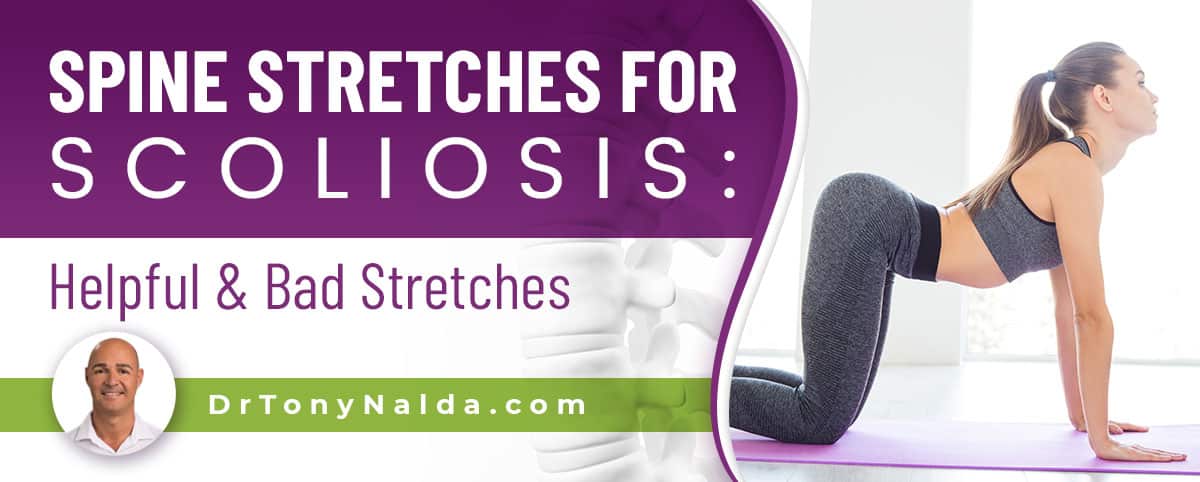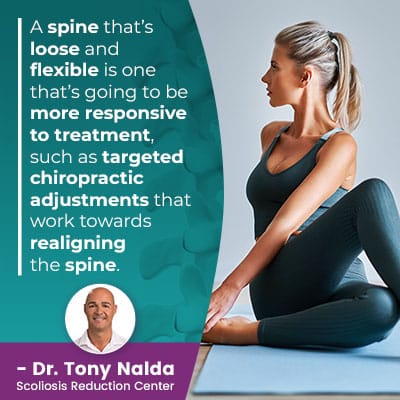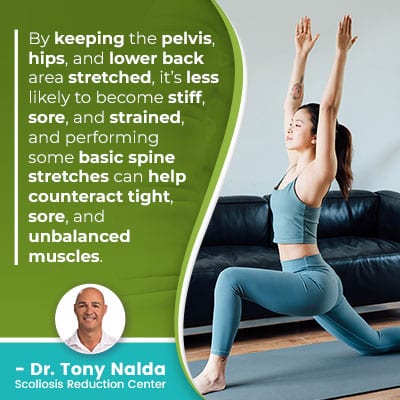Spine Stretches for Scoliosis: Helpful & Bad Stretches

There was a time when the role of exercise in scoliosis treatment was questioned, but that has since changed. Now, we know that when combined with other forms of corrective treatment, spine stretches for scoliosis can help with keeping the spine and its surroundings as loose and flexible as possible: increasing treatment efficacy.
Although no stretch on its own can impact scoliosis on a structural level, when integrated into a proactive treatment plan, scoliosis-specific stretches can be a valuable tool for strengthening and relaxing uneven muscles; bad spine stretches for scoliosis tend to work the spine asymmetrically.
There is a big difference between general stretches and exercises and scoliosis-specific stretches and exercises with corrective potential. Before getting to the specifics of good and bad stretches for scoliosis, let’s first discuss what it means to be diagnosed with scoliosis.
Table of Contents
Being Diagnosed with Scoliosis
Being diagnosed with scoliosis means an unnatural sideways spinal curve, with rotation, and a minimum Cobb angle of 10 degrees has developed.
The rotational component is what makes scoliosis a 3-dimensional condition as the spine doesn’t just bend unnaturally to the side but also twists from front to back, back to front.
The Cobb angle is a measurement taken during an X-ray that tells me how far out of alignment a scoliotic spine is and further classifies conditions based on severity:
- Mild scoliosis: Cobb angle measurement of between 10 and 25 degrees
- Moderate scoliosis: Cobb angle measurement of between 25 and 40 degrees
- Severe scoliosis: Cobb angle measurement of 40+ degrees
- Very-severe scoliosis: Cobb angle measurement of 80+ degrees
As you can see from the wide range of Cobb angle measurements, scoliosis is a highly-variable condition, which is why its very nature necessitates a customized treatment approach.
In addition to different severity levels, patient age, curvature location, and condition type also help shape a person’s experience of life with the condition.
Scoliosis Stretches for Pain Management
Scoliosis introduces a lot of uneven forces to the body, and those uneven forces cause disruptions to the body’s overall symmetry, and the types of postural deviation that develop can result in uneven muscle use and strained/sore muscles.
When muscles aren’t being used evenly, muscles on one side of the body tend to become excessively tight, while the muscles on the other side can become weaker.
 The tight muscles will need to be stretched, relaxed, and loosened, while the weak muscles on the opposite side need to be strengthened, and this is where spine stretches for scoliosis, and exercises can help counteract muscle imbalance and strain.
The tight muscles will need to be stretched, relaxed, and loosened, while the weak muscles on the opposite side need to be strengthened, and this is where spine stretches for scoliosis, and exercises can help counteract muscle imbalance and strain.
While general stretches will fall short when it comes to impacting the specific muscles and areas needed for scoliosis, condition-specific stretches can be a helpful component of treatment and pain management.
A spine that’s loose and flexible is one that’s going to be more responsive to treatment, such as targeted chiropractic adjustments that work towards realigning the spine.
In fact, as progression makes the spine increasingly rigid, especially in my adult patients, it’s not uncommon to have to do some preparatory work prior to starting the regular course of treatment to establish a baseline level of spinal flexibility.
As a scoliosis chiropractor, I know the spine, and I know scoliosis, and I can combine condition-specific treatment disciplines in a way that they complement one another for the most specific and customized results.
Now that we’ve talked generally about how spine stretches can help with pain management and treatment efficacy, let’s move on to addressing specific spine stretches for scoliosis that are helpful and those that should be avoided.
Helpful Spine Stretches for Scoliosis
When it comes to helpful stretches for scoliosis, no stretch or exercise should be attempted before first having it cleared by the patient’s treatment provider, and the following recommendations are meant to be used as a guide and in no way replace a physical exam or assessment; remember each case of scoliosis is unique and will have its own unique treatment needs.
As a CLEAR-certified scoliosis chiropractor, I follow the CLEAR Scoliosis Institute’s treatment protocols when it comes to recommending stretches, exercises, and other facets of treatment.
When we’re talking about stretches that are helpful for scoliosis, we’re talking about stretches that help keep the spine and its surrounding muscles as strong, loose, and flexible as possible.
Spine stretches that are known to be helpful for scoliosis include the latissimus dorsi stretch, the piriformis stretch, the psoas stretch, and the pelvic tilt.
The Latissimus Dorsi Stretch
The latissimus dorsi stretch is highly effective at working the largest muscle of the upper body, and for people with thoracic scoliosis (upper/middle back), this stretch can be particularly helpful as it directly impacts the latissimus dorsi muscle.
A latissimus dorsi stretch is safely performed by standing up straight in a neutral position while keeping the feet squared with the shoulders and the knees slightly bent.
Next, extend both hands over the head and grasp the right wrist with the left hand, then bend the body towards the right side until a stretch is felt on the left side.
Hold the stretch for a couple of breaths and then return to the starting position and repeat the stretch on the opposite side.
Doing this for 5 to 10 reps on each side of the body can help keep the largest muscle of the upper back loose, flexible, and functioning optimally.
The Piriformis Stretch
The piriformis stretch can be helpful for people with scoliosis by stretching the area between the hips and the tailbone; the piriformis muscle is fan-shaped and can become tight on the side of the hip rotating forward, which happens when the scoliotic curve pulls on the pelvis, disrupting its position and causing one hip to sit higher than the other.
In typical scoliosis cases, the curve bends to the right, away from the heart, but in atypical cases, it bends to the left, towards the heart, and this can cause excessive tightness in the piriformis muscle’s right side.
When performed correctly, the stretch can help maintain flexibility in the area, reduce pain, and can be done safely and easily at home without the need for equipment.
First, sit down on the floor with the legs crossed, and cross the leg that’s going to be stretched across the top of the opposite leg.
Bend the knee, and pull it tight into the chest until you feel a stretch underneath the hips; hold the stretch for 10 seconds, and repeat the stretch gently approximately ten times to further loosen up the area.
The Psoas Stretch
The psoas muscle flexes the hip and facilitates the spine’s ability to bend sideways, and because of the rotational component of the condition, the psoas stretch can be particularly helpful because of its strong derotation effect on the vertebrae of the lumbar spine (lower back): an ideal stretch for people with scoliosis in their lower backs.
This is another reason why it’s so essential to consult with a scoliosis specialist on the types of stretches and exercises that are the most beneficial for a person’s specific condition type, severity level, curvature type, and location.
For people whose scoliosis bends to the left, the stretch would be performed on the right side, and for people whose scoliosis bends to the right, the stretch would be performed on the left.
For stretching the left psoas, kneel down on the left knee with the right leg out in front, then lift the left arm and extend it over the head.
Slowly tilt the body forward while trying to maintain balance and hold the stretch for 60 seconds.
 The Pelvic Tilt
The Pelvic Tilt
Another stretch that’s particularly good for people with lumbar scoliosis is the pelvic tilt, which is ideal for stretching tight hip muscles and the lower back area.
A pelvic tilt can be performed by laying flat on the back with the knees bent and the feet flat on the floor.
While flattening the back by pressing it into the floor, try to engage the core, so the abdominal muscles are being worked.
Hold the stretch for 5 seconds and release, with two sets of ten producing optimal results.
By keeping the pelvis, hips, and lower back area stretched, it’s less likely to become stiff, sore, and strained, and performing some basic spine stretches can help counteract tight, sore, and unbalanced muscles.
Spine Stretches for Scoliosis to Avoid
When it comes to spine stretches that are best avoided by people with scoliosis, what might not be deemed an appropriate stretch for one patient, could be safe for another and vice versa, so again, when it comes to stretches that should be avoided, or approached with caution, first consult the medical professional in charge of treatment.
In general, the types of spine stretches that should be avoided by people with scoliosis include those that overuse one side of the body, so the condition’s asymmetrical effects are exacerbated, those that place the spine in an unnatural position that increases adverse spinal tension, and those that put the spine at increased risk of strain or injury.
Certain yoga poses that involve hyperextending the spine can be harmful to people with scoliosis, as can certain exercises that were once considered standard, like sit-ups, that are now known to strain the spine by pushing it into the floor and placing it in an unnatural position.
In addition, any stretches that involve repeatedly bending the head forward and down is bad for the cervical spine and upper back by increasing the weight of the head on the neck and potentially leading to the development of forward head posture.
Conclusion
When it comes to knowing the types of stretches and exercises that are helpful for people with scoliosis and those that are harmful, consulting a medical professional is always the first step.
As scoliosis introduces so many uneven forces to the body, efforts need to be made to counteract the condition’s uneven forces, and a big part of that is keeping the spine and its surrounding muscles as loose and flexible as possible.
Keeping the muscles that surround the spine as strong and loose as possible can help with muscle imbalance and pain management; it’s not just the spine that’s in charge of maintaining its natural curves and alignment but also its surrounding muscles.
Stretches like the piriformis, the psoas, and the pelvic tilt can help keep specific areas of the body, known to be affected by scoliosis, as strong and loose as possible, and this also helps with pain management.
If the core muscles are strong, they can provide the spine with optimal support and stabilization.
Here at the Scoliosis Reduction Center, I integrate a variety of condition-specific exercises and stretches to help facilitate corrective results, complement other forms of treatment, and make the spine more responsive to treatment.
Dr. Tony Nalda
DOCTOR OF CHIROPRACTIC
After receiving an undergraduate degree in psychology and his Doctorate of Chiropractic from Life University, Dr. Nalda settled in Celebration, Florida and proceeded to build one of Central Florida’s most successful chiropractic clinics.
His experience with patients suffering from scoliosis, and the confusion and frustration they faced, led him to seek a specialty in scoliosis care. In 2006 he completed his Intensive Care Certification from CLEAR Institute, a leading scoliosis educational and certification center.
About Dr. Tony Nalda
 Ready to explore scoliosis treatment? Contact Us Now
Ready to explore scoliosis treatment? Contact Us Now





